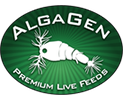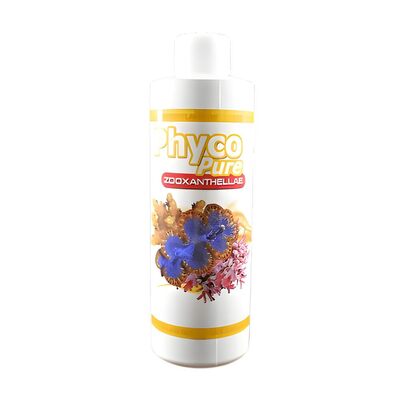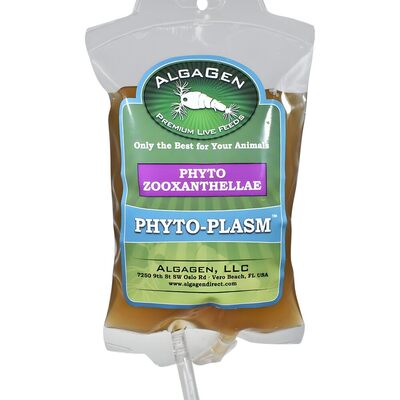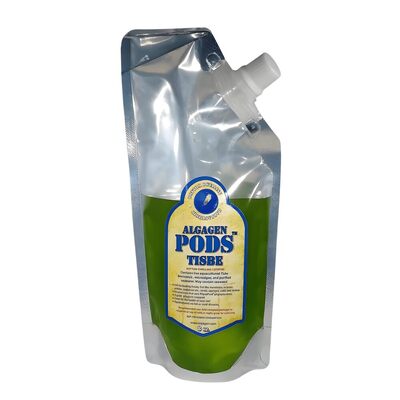Phytoplankton ranges from being incredibly useful to animals and man to being extremely toxic, similar to land plants. In general, phytoplankton utilize nutrients and carbon dioxide to grow and in doing so produce nutrition and compounds that are extremely beneficial to animals and humans; proteins, anti-biotics, anti-inflammatories, fatty acids, immune stimulating, anti-tumoral compounds etc. The most common uses of phytoplankton are in aquaculture, and as human/animal supplements.
At AlgaGen we provide microalgae/phytoplankton for all these purposes. We have 9 species in production, 24/7, dedicated to the needs of aquaculture and the marine ornamental hobby. The species we have identified have properties known to be incredibly important to raising marine organisms. We package these phytoplankton/microalgae in our PhycoPure line as Greenwater, CopePOD Blend, Reef Blend and PhycoPure Zooxanthellae.
The benefits of Phytoplankton to the reef tank are plenty
- delivers nutrition to countless feeding organisms.
- feeds the POD life in a tank
- Live Phyto/microalgae will utilize excess nutrients
- Live Phyto/microalgae will consume carbon dioxide and help to buffer water pH
- Live Phytoplankton will bind toxic heavy metals that may have gotten into a reef system
How to feed Phytoplankton
As with any new addition to a reef tank start off slowly. Such as one (1) capful, 1-2x per week. Do this for 1-2 weeks. Increase the phytoplankton/microalgae addition during the third week to 2 cap fulls, 2-3 times per week. Consistency is the key. If you add phytoplankton consistently you will see positive results. The sporadic addition of Phyto could cause a system to swing out of balance, similar to sporadically paying attention to water chemistry. Many organisms like an environment that is dependable.
The limits of how much to feed a reef tank is unknown and a hot topic. We work with groups of people who feed HEAVY and have incredible tanks. In the future we will highlight their approach to learn from.
Types of Phytoplankton and Usefulness
Isochrysis galbana (T); a brown microaglae that comes from Tahiti originally (T. Iso). It is high in a fatty acid called DHA which is critical to larval fish development the marine food chain. It is also important for human brain health. It is 4-6um and is used to feed clams, oysters, copepods, corals; used as an enrichment for rotifers and brine. It likes warm conditions 25-28C, is brown and full of beneficial accessory pigments that boost the immune system and eye health. There is a strain that comes from the Bahamas called C. Iso which slightly more temperature tolerant. This is a swimming microalgae and is used in mesocosm type larval approaches.
Thalassiosira weissflogii; is a brown diatom. The strain we use came from Hawaii and is tolerant of Hi-temperatures. This diatom is rich in fatty acids that are important to larval shrimp production. It is a larger diatom 7-10um and requires silica in addition to nitrate and phosphate to be cultured. This diatom is a floater and not a swimmer
Chaetoceros gracilis; is a brown diatom 2-4um in size, It is a fast grower and has been used to feed many organisms such as copepods, clams, oysters, larval shrimp and is a good enrichment for brine and rotifers. It has a critical fatty acid called ARA which is important to the marine food chain. Our strain came from the middle of the Atlantic and has been used extensively in aquaculture for decades prior to finding its way into our collection. It is a floating organism. It is a square cell with "spines" and is used in mesocosm type larval approaches.
Nannochloropsis oculata; 1-2um to 4-5 um green cell. Our strain is a 4-5um cell that came from a prolific clownfish breeder back in the early 2000's. Nannochloropsis is loaded with EPA a critical fatty acid for larval development as well as brain health in humans. It is a green single cell that floats and has been used forever in "greenwater" applications. It handles high-light, agitation and is considered a weed. Used primarily to raise rotifers and feed brine.
Tetraelmis suecica; is a 4-6um green motile cell. This strain originated from Sweden and is favorite of fish breeders, shrimp hatcheries and certain bivalves. It is rich in fatty acids but considered by many to have antibiotic properties. It like higher light and agitation after the 2 day of culture. It does much better at colder temperatures and has been reported to thrive under sheets of ice during the winters in the Northeast US. Under the microscope one can see remnants
Pavlova (Monochrysis lutherii) 3-5um brown cell. Pavlova is a cooler water phytoplankton that moves lazily through the water column. Under the microscope one can see the fatty acid deposits within the cell. This is a great phytoplankton for growing many organisms. it can absolutely produce copepods, enrich rotifers, brine, be used in cooler water mesocosm, feed clams and oysters. It is not used expansively because it is NOT that easy to culture but has great impact when used.
Rhodomonas lens; is a red -4-7 um sized cell that is motile. It is similar in impact to Pavlova in that it has been accredited with being able to feed sensitive larvae such as diadema larvae (sea urchin). It is powerful when used to grow copepods and enrich rotifers and brine. It does not like a lot of light and warmer temperatures. It is not an easy one to culture.
Zooxanthellae: brown 2-4 um cell that switches in between being motile and stationary. There are many types called clades (family equivalent). The real name is symbodinium and is considered a dinoflagellate. It is used to enhance coral health as well as health of the ornamental clams. We notice a strong fatty acid smell and have seen copepods growing well on this organism. It is NOT easy to grow, especially at higher cell numbers.





Recent post